本文共 17173 字,大约阅读时间需要 57 分钟。
转自:
本文主要包括:
- 一、什么是LSTM
- 二、LSTM的曲线拟合
- 三、LSTM的分类问题
- 四、为什么LSTM有助于消除梯度消失
一、什么是LSTM
Long Short Term 网络即为LSTM,是一种循环神经网络(RNN),可以学习长期依赖问题。RNN 都具有一种重复神经网络模块的链式的形式。在标准的 RNN 中,这个重复的模块只有一个非常简单的结构,例如一个 tanh 层。
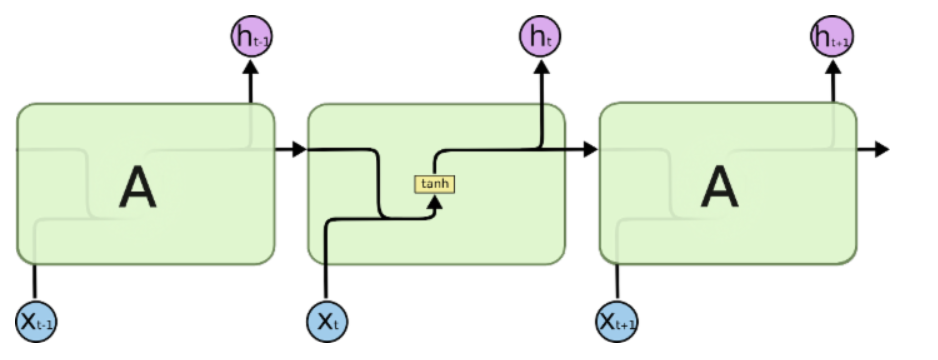
如上为标准的RNN神经网络结构,LSTM则与此不同,其网络结构如图:
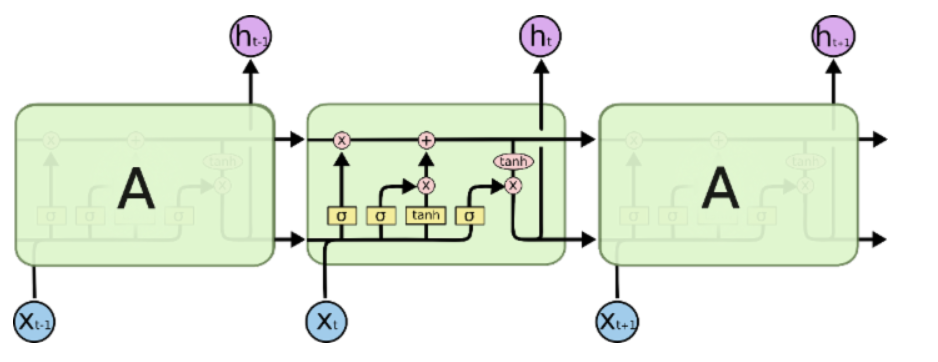
其中,网络中各个元素图标为:

LSTM 通过精心设计的称作为“门”的结构来去除或者增加信息到细胞状态的能力。门是一种让信息选择式通过的方法。他们包含一个 sigmoid 神经网络层和一个 pointwise 乘法操作。LSTM 拥有三个门,来保护和控制细胞状态。
首先是忘记门:

如上,忘记门中需要注意的是,训练的是一个wf的权值,而且上一时刻的输出和当前时刻的输入是一个concat操作。忘记门决定我们会从细胞状态中丢弃什么信息,因为sigmoid函数的输出是一个小于1的值,相当于对每个维度上的值做一个衰减。
然后是信息增加门,决定了什么新的信息到细胞状态中:

其中,sigmoid决定了什么值需要更新,tanh创建一个新的细胞状态的候选向量Ct,该过程训练两个权值Wi和Wc。经过第一个和第二个门后,可以确定传递信息的删除和增加,即可以进行“细胞状态”的更新。

第三个门就是信息输出门:

通过sigmoid确定细胞状态那个部分将输出,tanh处理细胞状态得到一个-1到1之间的值,再将它和sigmoid门的输出相乘,输出程序确定输出的部分。
二、LSTM的曲线拟合
2.1 股票价格预测
下面介绍一个网上常用的利用LSTM做股票价格的回归例子,:

如上,可以看到用例包含:index_code,date,open,close,low,high,volume,money,change这样几个特征。提取特征从open-change个特征,作为神经网络的输入,输出即为label。整个代码如下:
import pandas as pdimport numpy as npimport matplotlib.pyplot as pltimport tensorflow as tf #定义常量rnn_unit=10 #hidden layer unitsinput_size=7output_size=1lr=0.0006 #学习率#——————————————————导入数据——————————————————————f=open('dataset_2.csv')df=pd.read_csv(f) #读入股票数据data=df.iloc[:,2:10].values #取第3-10列 #获取训练集def get_train_data(batch_size=60,time_step=20,train_begin=0,train_end=5800): batch_index=[] data_train=data[train_begin:train_end] normalized_train_data=(data_train-np.mean(data_train,axis=0))/np.std(data_train,axis=0) #标准化 train_x,train_y=[],[] #训练集 for i in range(len(normalized_train_data)-time_step): if i % batch_size==0: batch_index.append(i) x=normalized_train_data[i:i+time_step,:7] y=normalized_train_data[i:i+time_step,7,np.newaxis] train_x.append(x.tolist()) train_y.append(y.tolist()) batch_index.append((len(normalized_train_data)-time_step)) return batch_index,train_x,train_y #获取测试集def get_test_data(time_step=20,test_begin=5800): data_test=data[test_begin:] mean=np.mean(data_test,axis=0) std=np.std(data_test,axis=0) normalized_test_data=(data_test-mean)/std #标准化 size=(len(normalized_test_data)+time_step-1)//time_step #有size个sample test_x,test_y=[],[] for i in range(size-1): x=normalized_test_data[i*time_step:(i+1)*time_step,:7] y=normalized_test_data[i*time_step:(i+1)*time_step,7] test_x.append(x.tolist()) test_y.extend(y) test_x.append((normalized_test_data[(i+1)*time_step:,:7]).tolist()) test_y.extend((normalized_test_data[(i+1)*time_step:,7]).tolist()) return mean,std,test_x,test_y #——————————————————定义神经网络变量——————————————————#输入层、输出层权重、偏置 weights={ 'in':tf.Variable(tf.random_normal([input_size,rnn_unit])), 'out':tf.Variable(tf.random_normal([rnn_unit,1])) }biases={ 'in':tf.Variable(tf.constant(0.1,shape=[rnn_unit,])), 'out':tf.Variable(tf.constant(0.1,shape=[1,])) } #——————————————————定义神经网络变量——————————————————def lstm(X): batch_size=tf.shape(X)[0] time_step=tf.shape(X)[1] w_in=weights['in'] b_in=biases['in'] input=tf.reshape(X,[-1,input_size]) #需要将tensor转成2维进行计算,计算后的结果作为隐藏层的输入 input_rnn=tf.matmul(input,w_in)+b_in input_rnn=tf.reshape(input_rnn,[-1,time_step,rnn_unit]) #将tensor转成3维,作为lstm cell的输入 cell=tf.nn.rnn_cell.BasicLSTMCell(rnn_unit) init_state=cell.zero_state(batch_size,dtype=tf.float32) output_rnn,final_states=tf.nn.dynamic_rnn(cell, input_rnn,initial_state=init_state, dtype=tf.float32) #output_rnn是记录lstm每个输出节点的结果,final_states是最后一个cell的结果 output=tf.reshape(output_rnn,[-1,rnn_unit]) #作为输出层的输入 w_out=weights['out'] b_out=biases['out'] pred=tf.matmul(output,w_out)+b_out return pred,final_states #——————————————————训练模型——————————————————def train_lstm(batch_size=80,time_step=15,train_begin=2000,train_end=5800): X=tf.placeholder(tf.float32, shape=[None,time_step,input_size]) Y=tf.placeholder(tf.float32, shape=[None,time_step,output_size]) # 训练样本中第2001 - 5785个样本,每次取15个 batch_index,train_x,train_y=get_train_data(batch_size,time_step,train_begin,train_end) print(np.array(train_x).shape)# 3785 15 7 print(batch_index) #相当于总共3785句话,每句话15个字,每个字7个特征(embadding),对于这些样本每次训练80句话 pred,_=lstm(X) #损失函数 loss=tf.reduce_mean(tf.square(tf.reshape(pred,[-1])-tf.reshape(Y, [-1]))) train_op=tf.train.AdamOptimizer(lr).minimize(loss) saver=tf.train.Saver(tf.global_variables(),max_to_keep=15) with tf.Session() as sess: sess.run(tf.global_variables_initializer()) #重复训练200次 for i in range(200): #每次进行训练的时候,每个batch训练batch_size个样本 for step in range(len(batch_index)-1): _,loss_=sess.run([train_op,loss],feed_dict={X:train_x[batch_index[step]:batch_index[step+1]],Y:train_y[batch_index[step]:batch_index[step+1]]}) print(i,loss_) if i % 200==0: print("保存模型:",saver.save(sess,'model/stock2.model',global_step=i)) train_lstm() #————————————————预测模型————————————————————def prediction(time_step=20): X=tf.placeholder(tf.float32, shape=[None,time_step,input_size]) mean,std,test_x,test_y=get_test_data(time_step) pred,_=lstm(X) saver=tf.train.Saver(tf.global_variables()) with tf.Session() as sess: #参数恢复 module_file = tf.train.latest_checkpoint('model') saver.restore(sess, module_file) test_predict=[] for step in range(len(test_x)-1): prob=sess.run(pred,feed_dict={X:[test_x[step]]}) predict=prob.reshape((-1)) test_predict.extend(predict) test_y=np.array(test_y)*std[7]+mean[7] test_predict=np.array(test_predict)*std[7]+mean[7] acc=np.average(np.abs(test_predict-test_y[:len(test_predict)])/test_y[:len(test_predict)]) #偏差 #以折线图表示结果 plt.figure() plt.plot(list(range(len(test_predict))), test_predict, color='b') plt.plot(list(range(len(test_y))), test_y, color='r') plt.show() prediction() 这个过程并不难理解,下面分析其中维度变换,从而增加对LSTM的理解。
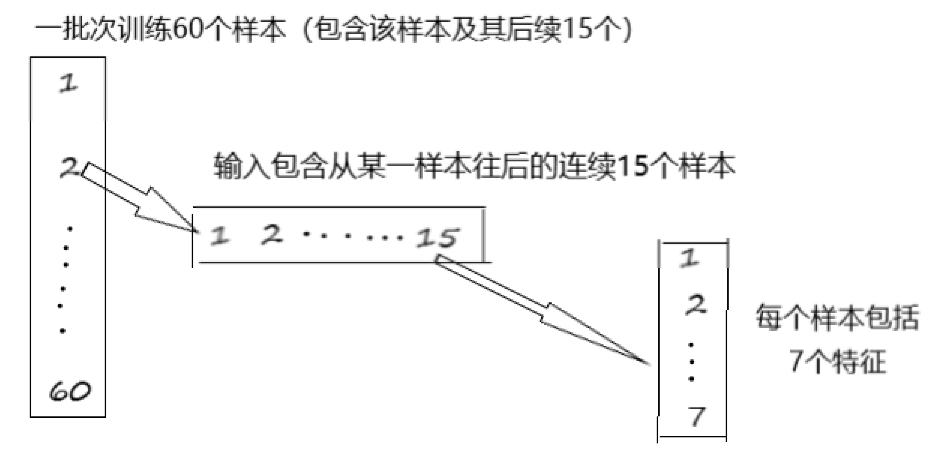
对于RNN的网络的构建,可以从输入张量的维度上理解,这里我们使用dynamic_rnn(当然可以注意与tf.contrib.rnn.static_rnn在使用上的区别):
dynamic_rnn( cell, inputs, sequence_length=None, initial_state=None, dtype=None, parallel_iterations=None, swap_memory=False, time_major=False, scope=None)
其中:
cell:输入一个RNNcell实例
inputs:RNN神经网络的输入,如果 time_major == False (default),输入的形状是: [batch_size, max_time, embedding_size];如果 time_major == True, 输入的形状是: [ max_time, batch_size, embedding_size]
initial_state: RNN网络的初始状态,网络需要一个初始状态,对于普通的RNN网络,初始状态的形状是:[batch_size, cell.state_size]
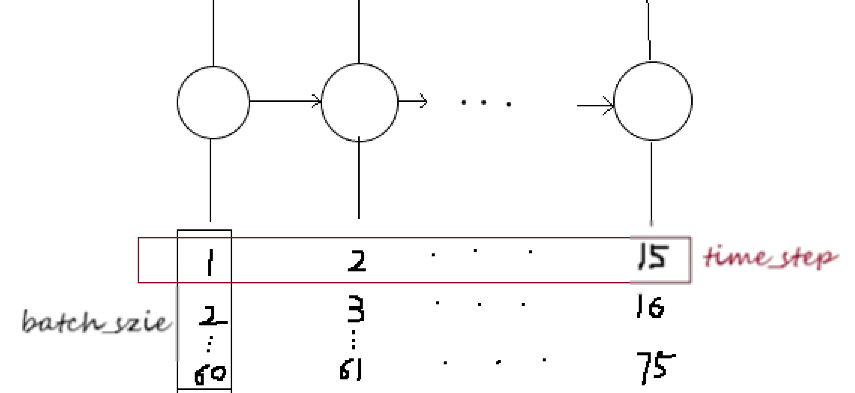
2.2 正弦曲线拟合
对于使用LSTM做曲线拟合,参考,得到代码:
import tensorflow as tfimport numpy as npimport matplotlib.pyplot as plt BATCH_START = 0 #建立 batch data 时候的 indexTIME_STEPS = 20 # backpropagation through time 的time_stepsBATCH_SIZE = 50INPUT_SIZE = 1 # x数据输入sizeOUTPUT_SIZE = 1 # cos数据输出 sizeCELL_SIZE = 10 # RNN的 hidden unit sizeLR = 0.006 # learning rate # 定义一个生成数据的 get_batch function:def get_batch(): #global BATCH_START, TIME_STEPS # xs shape (50batch, 20steps) xs = np.arange(BATCH_START, BATCH_START+TIME_STEPS*BATCH_SIZE).reshape((BATCH_SIZE, TIME_STEPS)) / (10*np.pi) res = np.cos(xs) # returned xs and res: shape (batch, step, input) return [xs[:, :, np.newaxis], res[:, :, np.newaxis]] # 定义 LSTMRNN 的主体结构class LSTMRNN(object): def __init__(self, n_steps, input_size, output_size, cell_size, batch_size): self.n_steps = n_steps self.input_size = input_size self.output_size = output_size self.cell_size = cell_size self.batch_size = batch_size with tf.name_scope('inputs'): self.xs = tf.placeholder(tf.float32, [None, n_steps, input_size], name='xs') self.ys = tf.placeholder(tf.float32, [None, n_steps, output_size], name='ys') with tf.variable_scope('in_hidden'): self.add_input_layer() with tf.variable_scope('LSTM_cell'): self.add_cell() with tf.variable_scope('out_hidden'): self.add_output_layer() with tf.name_scope('cost'): self.compute_cost() with tf.name_scope('train'): self.train_op = tf.train.AdamOptimizer(LR).minimize(self.cost) # 设置 add_input_layer 功能, 添加 input_layer: def add_input_layer(self, ): l_in_x = tf.reshape(self.xs, [-1, self.input_size], name='2_2D') # (batch*n_step, in_size) # Ws (in_size, cell_size) Ws_in = self._weight_variable([self.input_size, self.cell_size]) # bs (cell_size, ) bs_in = self._bias_variable([self.cell_size, ]) # l_in_y = (batch * n_steps, cell_size) with tf.name_scope('Wx_plus_b'): l_in_y = tf.matmul(l_in_x, Ws_in) + bs_in # reshape l_in_y ==> (batch, n_steps, cell_size) self.l_in_y = tf.reshape(l_in_y, [-1, self.n_steps, self.cell_size], name='2_3D') # 设置 add_cell 功能, 添加 cell, 注意这里的 self.cell_init_state, # 因为我们在 training 的时候, 这个地方要特别说明. def add_cell(self): lstm_cell = tf.contrib.rnn.BasicLSTMCell(self.cell_size, forget_bias=1.0, state_is_tuple=True) with tf.name_scope('initial_state'): self.cell_init_state = lstm_cell.zero_state(self.batch_size, dtype=tf.float32) self.cell_outputs, self.cell_final_state = tf.nn.dynamic_rnn(lstm_cell, self.l_in_y, initial_state=self.cell_init_state, time_major=False) # 设置 add_output_layer 功能, 添加 output_layer: def add_output_layer(self): # shape = (batch * steps, cell_size) l_out_x = tf.reshape(self.cell_outputs, [-1, self.cell_size], name='2_2D') Ws_out = self._weight_variable([self.cell_size, self.output_size]) bs_out = self._bias_variable([self.output_size, ]) # shape = (batch * steps, output_size) with tf.name_scope('Wx_plus_b'): self.pred = tf.matmul(l_out_x, Ws_out) + bs_out # 添加 RNN 中剩下的部分: def compute_cost(self): losses = tf.contrib.legacy_seq2seq.sequence_loss_by_example( [tf.reshape(self.pred, [-1], name='reshape_pred')], [tf.reshape(self.ys, [-1], name='reshape_target')], [tf.ones([self.batch_size * self.n_steps], dtype=tf.float32)], average_across_timesteps=True, softmax_loss_function=self.ms_error, name='losses' ) with tf.name_scope('average_cost'): self.cost = tf.div( tf.reduce_sum(losses, name='losses_sum'), self.batch_size, name='average_cost') tf.summary.scalar('cost', self.cost) def ms_error(self,labels, logits): return tf.square(tf.subtract(labels, logits)) def _weight_variable(self, shape, name='weights'): initializer = tf.random_normal_initializer(mean=0., stddev=1., ) return tf.get_variable(shape=shape, initializer=initializer, name=name) def _bias_variable(self, shape, name='biases'): initializer = tf.constant_initializer(0.1) return tf.get_variable(name=name, shape=shape, initializer=initializer) # 训练 LSTMRNNif __name__ == '__main__': # 搭建 LSTMRNN 模型 model = LSTMRNN(TIME_STEPS, INPUT_SIZE, OUTPUT_SIZE, CELL_SIZE, BATCH_SIZE) sess = tf.Session() saver=tf.train.Saver(max_to_keep=3) sess.run(tf.global_variables_initializer()) t = 0 if(t == 1): model_file=tf.train.latest_checkpoint('model/') saver.restore(sess,model_file ) xs, res = get_batch() # 提取 batch data feed_dict = {model.xs: xs} pred = sess.run( model.pred,feed_dict=feed_dict) xs.shape = (-1,1) res.shape = (-1, 1) pred.shape = (-1, 1) print(xs.shape,res.shape,pred.shape) plt.figure() plt.plot(xs,res,'-r') plt.plot(xs,pred,'--g') plt.show() else: # matplotlib可视化 plt.ion() # 设置连续 plot plt.show() # 训练多次 for i in range(2500): xs, res = get_batch() # 提取 batch data # 初始化 data feed_dict = { model.xs: xs, model.ys: res, } # 训练 _, cost, state, pred = sess.run( [model.train_op, model.cost, model.cell_final_state, model.pred], feed_dict=feed_dict) # plotting x = xs.reshape(-1,1) r = res.reshape(-1, 1) p = pred.reshape(-1, 1) plt.clf() plt.plot(x, r, 'r', x, p, 'b--') plt.ylim((-1.2, 1.2)) plt.draw() plt.pause(0.3) # 每 0.3 s 刷新一次 # 打印 cost 结果 if i % 20 == 0: saver.save(sess, "model/lstem_text.ckpt",global_step=i)# print('cost: ', round(cost, 4)) 可以看到一个有意思的现象,下面是先后两个时刻的图像:

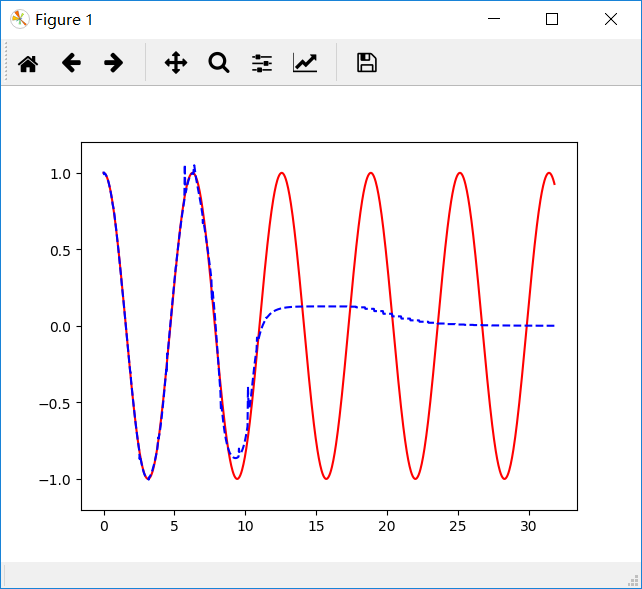
x值较小的点先收敛,x值大的收敛速度很慢。其原因主要是BPTT的求导过程,对于时间靠前的梯度下降快,可以参考: 中1.2节。将网络结构改为双向循环神经网络:
def add_cell(self): lstm_cell = tf.contrib.rnn.BasicLSTMCell(self.cell_size, forget_bias=1.0, state_is_tuple=True) lstm_cell = tf.contrib.rnn.MultiRNNCell([lstm_cell],1) with tf.name_scope('initial_state'): self.cell_init_state = lstm_cell.zero_state(self.batch_size, dtype=tf.float32) self.cell_outputs, self.cell_final_state = tf.nn.dynamic_rnn(lstm_cell, self.l_in_y, initial_state=self.cell_init_state, time_major=False) 发现收敛速度快了一些。不过这个问题主要还是是因为x的值过大导致的,修改代码,将原始的值的获取进行分段:
BATCH_START = 3000 #建立 batch data 时候的 indexTIME_STEPS = 20 # backpropagation through time 的time_stepsBATCH_SIZE_r = 50BATCH_SIZE = 10INPUT_SIZE = 1 # x数据输入sizeOUTPUT_SIZE = 1 # cos数据输出 sizeCELL_SIZE = 10 # RNN的 hidden unit sizeLR = 0.006 # learning rateii = 0# 定义一个生成数据的 get_batch function:def get_batch(): global ii # xs shape (50batch, 20steps) xs_r = np.arange(BATCH_START, BATCH_START+TIME_STEPS*BATCH_SIZE_r) xs = xs_r[ii*BATCH_SIZE*TIME_STEPS:(ii+1)*BATCH_SIZE*TIME_STEPS].reshape((BATCH_SIZE, TIME_STEPS)) / (10*np.pi) res = np.cos(xs) ii += 1 if(ii == 5): ii = 0 # returned xs and res: shape (batch, step, input) return [xs[:, :, np.newaxis], res[:, :, np.newaxis]]
然后可以具体观测某一段的收敛过程:
# matplotlib可视化 plt.ion() # 设置连续 plot plt.show() # 训练多次 for i in range(200): xs,res,pred = [],[],[] for j in range(5): xsj, resj = get_batch() # 提取 batch data if(j != 0): continue # 初始化 data feed_dict = { model.xs: xsj, model.ys: resj, } # 训练 _, cost, state, predj = sess.run( [model.train_op, model.cost, model.cell_final_state, model.pred], feed_dict=feed_dict) # plotting x = list(xsj.reshape(-1,1)) r = list(resj.reshape(-1, 1)) p = list(predj.reshape(-1, 1)) xs += x res += r pred += p plt.clf() plt.plot(xs, res, 'r', x, p, 'b--') plt.ylim((-1.2, 1.2)) plt.draw() plt.pause(0.3) # 每 0.3 s 刷新一次 # 打印 cost 结果 if i % 20 == 0: saver.save(sess, "model/lstem_text.ckpt",global_step=i)# print('cost: ', round(cost, 4)) 可以看到,当设置的区间比较大,譬如BATCH_START = 3000了,那么就很难收敛了。

因此,这里需要注意了,LSTM做回归问题的时候,注意观测值与自变量之间不要差距过大。当我们改小一些x的值,可以看到效果如图:
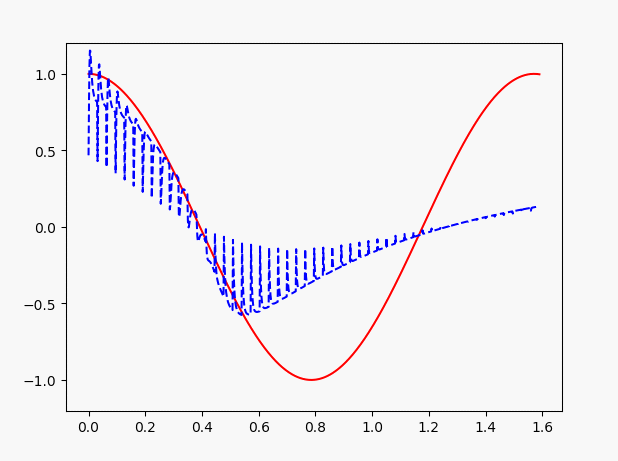
三、LSTM的分类问题
对于分类问题,其实和回归是一样的,假设在上面的正弦函数的基础上,若y大于0标记为1,y小于0标记为0,则输出变成了一个n_class(n个类别)的向量,本例中两个维度分别代表标记为0的概率和标记为1的概率。需要修改的地方为:
首先是数据产生函数,添加一个打标签的过程:
# 定义一个生成数据的 get_batch function:def get_batch(): #global BATCH_START, TIME_STEPS # xs shape (50batch, 20steps) xs = np.arange(BATCH_START, BATCH_START+TIME_STEPS*BATCH_SIZE).reshape((BATCH_SIZE, TIME_STEPS)) / (200*np.pi) res = np.where(np.cos(4*xs)>=0,0,1).tolist() for i in range(BATCH_SIZE): for j in range(TIME_STEPS): res[i][j] = [0,1] if res[i][j] == 1 else [1,0] # returned xs and res: shape (batch, step, input/output) return [xs[:, :, np.newaxis], np.array(res)]
然后修改损失函数,回归问题就不能用最小二乘的损失了,可以采用交叉熵损失函数:
def compute_cost(self): self.cost = tf.reduce_mean(tf.nn.softmax_cross_entropy_with_logits(labels = self.ys,logits = self.pred))
当然,注意一下维度问题就可以了,效果如图:

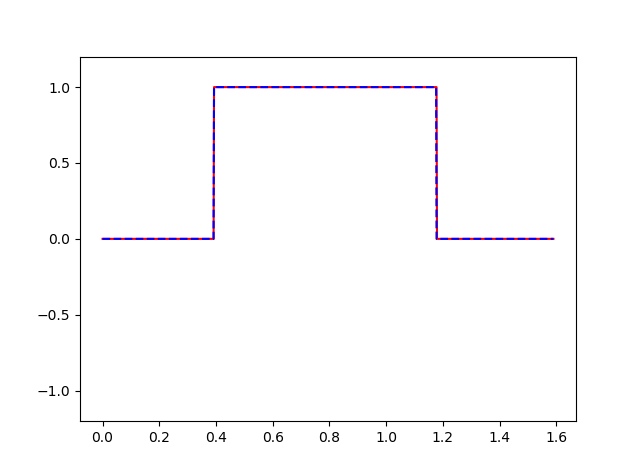
戳:
四、为什么LSTM有助于消除梯度消失
为了解决RNN的梯度问题,首先有人提出了渗透单元的办法,即在时间轴上增加跳跃连接,后推广成LSTM。LSTM其门结构,提供了一种对梯度的选择的作用。
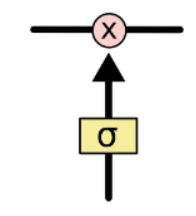
对于门结构,其实如果关闭,则会一直保存以前的信息,其实也就是缩短了链式求导。

譬如,对某些输入张量训练得到的ft一直为1,则Ct-1的信息可以一直保存,直到有输入x得到的ft为0,则和前面的信息就没有关系了。故解决了长时间的依赖问题。因为门控机制的存在,我们通过控制门的打开、关闭等操作,让梯度计算沿着梯度乘积接近1的部分创建路径。

如上,可以通过门的控制,看到红色和蓝色箭头代表的路径下,yt+1的在这个路径下的梯度与上一时刻梯度保持不变。
对于信息增加门与忘记门的“+”操作,其求导是加法操作而不是乘法操作,该环节梯度为1,不会产生链式求导。如后面的求导,绿色路径和蓝色路径是相加的关系,保留了之前的梯度。

然而,梯度消失现象可以改善,但是梯度爆炸还是可能会出现的。譬如对于绿色路径:
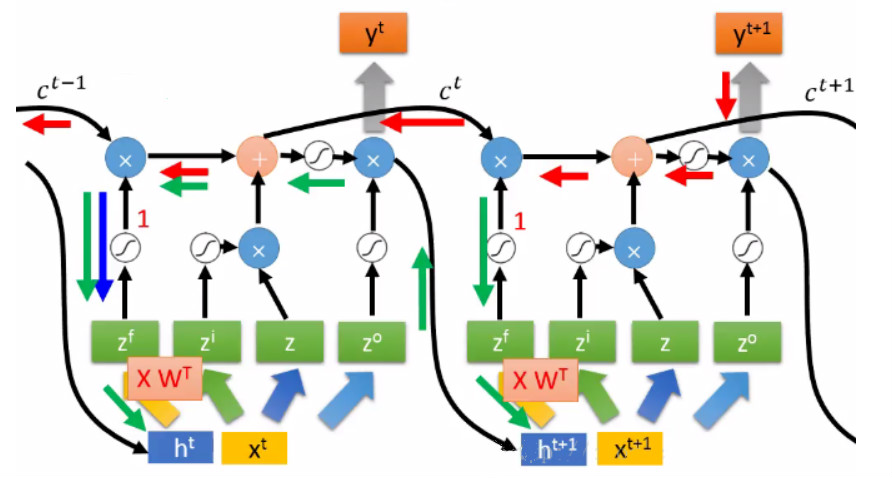
还是存在着w导致的梯度爆炸现象。
转载说明
感谢大佬详细的讲解~
本文转自:
作者:
出处: 本文版权归作者和博客园共有,欢迎批评指正及转载,但未经作者同意必须保留此段声明,且在文章页面明显位置给出原文连接,否则保留追究法律责任的权利。